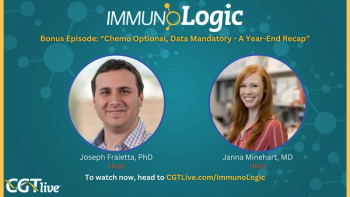
Allogeneic HSCT Yields Favorable Outcomes in Myelofibrosis
Jan Philipp Bewersdorf, MD, hospital resident at Yale University School of Medicine discussed the safety and efficacy of allogeneic hematopoietic stem cell transplant in myelofibrosis.
This content originally appeared on our sister site,
Allogeneic hematopoietic stem cell transplant (HSCT) remains the sole curative therapeutic modality for patients with myelofibrosis, despite recent significant therapeutic developments. Since high numbers of patients are often deemed ineligible for HSCT, it is crucial to examine the safety and efficacy of allogeneic HSCT to help guide treatment decisions for high-risk patients.
Jan Philipp Bewersdorf, MD, and other investigators led a systemic review and meta-analysis that examined safety and efficacy data for allogeneic HSCT from 43 prior studies. Results from the analysis, which were presented at the 2021 ASCO Annual Meeting, showed that the 1-, 2-, and 5-year overall survival (OS) rates for patients who underwent transplant were 66.7%, 64.4%, and 55.0%, respectively.
Because of this, investigators concluded that transplant should be considered for patients with high-risk myelofibrosis.
“We tried to synthesize the available evidence on the safety and efficacy of transplant in myelofibrosis, to identify patients, as well as disease and transplant characteristics, to see we could help physicians to better counsel patients and select them for this therapeutic modality,” Bewersdorf said.
In an interview with OncLive, Bewersdorf, a hospital resident at Yale University School of Medicine, discussed the outcomes and risks of allogeneic HSCT in patients with myelofibrosis, as well as remaining questions for the modality.
OncLive: Could you discuss the rationale for this analysis in myelofibrosis?
Bewersdorf: [For patients with] myelofibrosis, the only potentially curative therapeutic modality is allogeneic HSCT. However, this is a procedure that is associated with significant risks, especially related to graft-vs-host disease [GVHD], as well as the ensuing immunosuppression and graft failure. It is very important to identify patients that are candidates for this curative therapy, but also not expose them to unnecessary risk.
Unfortunately, most patients with myelofibrosis are older and not transplant eligible. There has never been a randomized clinical trial that compares transplant vs no transplant, and that is where the lack of high-quality evidence to guide treatment selection comes in. As such, we tried to synthesize the available evidence on the safety and efficacy of transplant in myelofibrosis to identify patients, as well as disease and transplant characteristics, to see we could help physicians to better counsel patients and select them for this therapeutic modality.
What methods were implemented to evaluate this? What methods and design were utilized on the trial?
We conducted a systematic review, as well as a meta-analysis, and this was done in conjunction with a medical librarian who had extensive experience in the field. A search strategy was devised, and it was then peer reviewed by a separate librarian. The study protocol was then prospectively registered on a platform called PROSPERO, which is the standard for systematic reviews and meta-analyses. We searched multiple databases looking for all studies, from inception to our study cutoff date, which was October 2020, which reported outcomes on allogeneic transplant in myelofibrosis. The co-primary end points were 1-year, 2-year, and 5-year OS.
This provided information across the entire spectrum, from early mortality to 5-year OS, which could be considered a surrogate for long-term survival. At the same time, we were looking into safety and key outcomes, including the incidence and severity of GVHD, graft failure, and nontransplant-related mortality. We then conducted several subgroup analyses based on underlying disease risk, stratified by the Dynamic International Prognostic Scoring System, as well as patient age and the intensity of their conditioning regimen.
What were the key efficacy findings observed from the analysis?
The search retrieved 43 studies that were eligible for inclusion [on our analysis], and those studies reported outcomes on 8700 patients. The studies were conducted from the 1990s through 2020. This is a huge spectrum of patients, with various treatment characteristics, and depicts the development in the field over the last few decades. [In terms of OS rates, we found that they were] 66.7% at 1 year and 55.0% at 5 years.
The big caveat is that this is not a randomized clinical trial. There is certainly some selection bias, in terms of which patient proceeds to transplant vs most patients with myelofibrosis that never make it to transplant because they are older or have significant comorbidities. However, for patients with higher-risk myelofibrosis, compared with those who do not undergo transplant, those results compare favorably.
In terms of safety, what was observed from the analysis?
We looked at 2 safety outcomes: non-relapse mortality and GVHD. This is one of our main findings, in my opinion, especially when we counsel patients. Rates of 1-year non-relapse mortality were 25.9%, which is a significant number. It increases slightly over time, but most transplant-related mortality occurs within the first year. At 5 years, we had a non-relapse mortality rate of 30.5%.
Graft failure occurred at a rate of 7%, which is much higher compared with other diseases where we do allogeneic transplant, including acute myeloid leukemia. However, it is not unexpected in myelofibrosis.
This is less devastating than death, but something that will have a significant impact on the quality of life [QoL], time in the hospital, and healthcare expenses, is acute GVHD which has an incidence rate of 44%. This is across all severity grades and includes grade 2 GVHD, which is very manageable, but we also found that 15% [of patients developed] grade 3/4 GVHD. For chronic GVHD, we found an incidence rate of 46.5%.
What are the clinical implications of these findings?
The main conclusion is that myelofibrosis has a poor prognosis, but it occurs along a spectrum. There are patients with low-risk myelofibrosis who do very well over many years. [Some of these patients] have significant comorbidities, but we have novel treatments like ruxolitinib [Jakafi], as well as other JAK inhibitors, that have significantly improved the quality of -life, and overall survival benefit. [However, these treatments are not] disease modifying. They are not curative.
The only curative option is transplant. For young patients with high-risk disease, and potentially some cytogenetic abnormalities or mutations, they should be considered for transplant. The 5- year OS rate of 55% highlights how it has a substantial impact compared with patients who do not go to transplant. However, patient selection is key, and safety needs to be taken into consideration.
Are there any next steps planned with this research?
The main purpose was to summarize and synthesize the current state of the evidence, and to highlight what we already know, what we do not know, and explain what the shortcomings in the current state of the evidence are. We were unable to evaluate the impact of cytogenetic abnormalities, and certain mutational testing was not able to be performed because most of our studies were republished when those tests were not widely available. As such, we do not know if a patient who has a certain mutation is at higher risk and should undergo transplant.
Additionally, ruxolitinib was approved years ago, but many of the studies we examined were conducted before that was the standard of care. In patients who received treatment with ruxolitinib either before or after transplant, we do not know the impact of the agent, or any other JAK inhibitors, on the outcomes. We have seen developments in transplant overall, with better donor selection, changes in conditioning regimens, and GVHD prophylaxis.
All of these impacts are very interesting for myelofibrosis, but this is something that should ideally be studied in a clinical trial.
Reference
Bewersdorf J, Sheth A, Vetsa S, et al. Outcomes of allogeneic hematopoietic cell transplantation in patients with myelofibrosis: a systematic review and meta-analysis. J Clin Oncol. 2021;39(15): 7045. doi:10.1200/JCO.2021.39.15_suppl.7045
Newsletter
Stay at the forefront of cutting-edge science with CGT—your direct line to expert insights, breakthrough data, and real-time coverage of the latest advancements in cell and gene therapy.





































